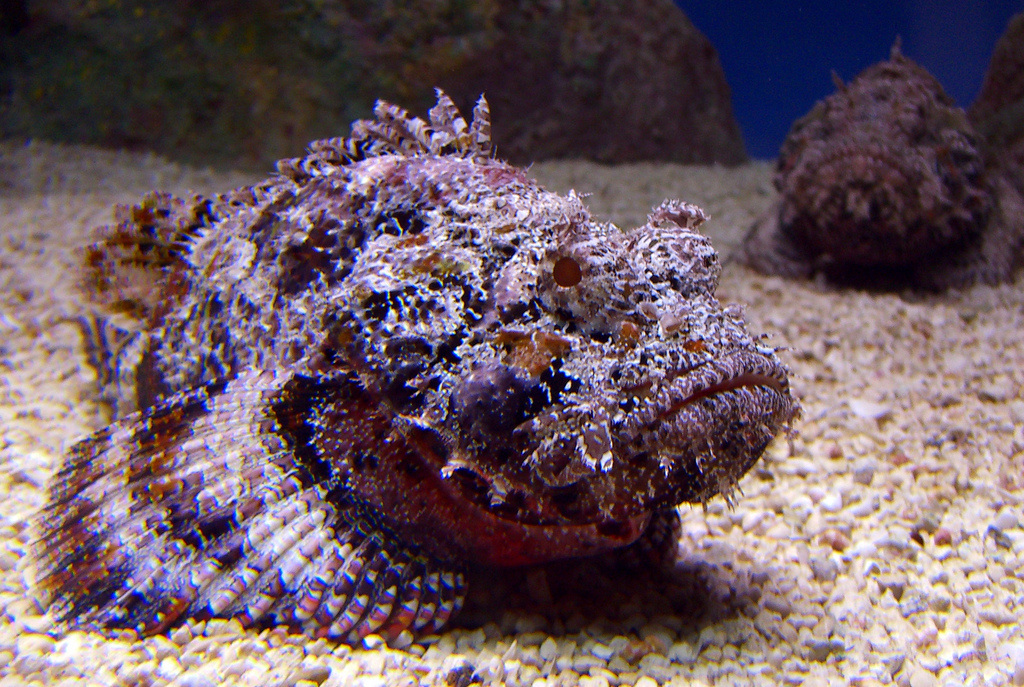


Most alien species on the coasts of Turkey were originated from the Red Sea (58%), due to the proximity of the country to the Suez Canal. only 11% of species introductions in the Black Sea. The vectoral importance of the Suez Canal diminishes when moving from south to north, accounting for 72% of species introductions in the Levantine Sea vs. The number of alien species found in seas surrounding Turkey ranged from 28 (Black Sea) to 413 (Levantine Sea). Mollusca ranked first in terms of the number of species (123 species), followed by Foraminifera (91 species), Pisces (80 species) and Arthropoda (79 species).

Among the established species, 105 species have invasive characters at least in one zoogeographic region, comprising 19% of all alien species. The present compilation includes reports of an ascidian species (Rhodosoma turcicum) new to the marine fauna of Turkey and range extensions of six species.
STONE FISH UPDATE
A total of 185 new alien species have been added to the list since the previous update of 2011. The 2020's update of marine alien species list from Turkey yielded a total of 539 species belonging to 18 taxonomic groups, 404 of which have become established in the region and 135 species are casual. Holistic approaches and experimental research constitute the way forward to better understanding and managing biological invasions. There was no evidence that the magnitude of impact increases with residence time. Substantial variation was found among Mediterranean ecoregions in terms of mechanisms of impact and the taxonomic identity of impacting species. For human health, only negative impacts were recorded. Overall, more positive than negative impacts were reported on ecosystem services, but this varied depending on the service. Most cases of combined negative and positive impacts on biodiversity referred to community-level modifications. Competition for resources, the creation of novel habitat through ecosystem engineering, and predation were the primary reported mechanisms of negative effects. Negative impacts on biodiversity prevailed over positive ones. The ten worst invasive species in terms of reported negative impacts on biodiversity include six algae, two fishes, and two molluscs, with the green alga Caulerpa cylindracea ranking first. Our assessment allowed us to create an inventory of 88 alien and cryptogenic species from 16 different phyla with reported moderate to high impacts. Only 16% of the reported impacts were based on experimental studies. Evidence for most reported impacts (52%) was of medium strength, but for 32% of impact reports evidence was weak, based solely on expert judgement. Overall, 103 alien and cryptogenic species were analysed, 59 of which were associated with both negative and positive impacts, 17 to only negative, and 13 to only positive no impacts were found for 14 species. We screened relevant literature and applied a standardised framework that classifies mechanisms and magnitude of impacts and type of evidence. We systematically reviewed the current knowledge on the impacts of marine biological invasions in the Mediterranean Sea.

2017a).īiological invasions have become a defining feature of marine Mediterranean ecosystems with significant impacts on biodiversity, ecosystem services, and human health. 2013) the predation pressure of massive swarms can pose a threat for native biodiversity Mannino et al. Furthermore, the invasive jellyfish is a voracious predator that consumes shrimps, mollusks and fish larvae (Otero et al. 1997 Yoffe and Baruchin 2004 Öztürk and Isinibilir 2010 Çinar et al. nomadica swarms are considered hazardous to human health as the invasive jellyfish contains venom in its tentacles and has caused a great number of hospitalizations of swimmers and fishers in the eastern Mediterranean due to its painful stings that may cause a variety of symptoms such as pain, erythematous eruptions, swelling, itching and burning sensations, fever, chills, fatigue, muscular aches and spasms, vomiting and even respiratory distress and anaphylactic reactions (Galil et al. Microbial communities change and ultimately may cause a decrease in primary production that will shift the already oligotrophic ecosystems of the Levantine Sea to further degradation (Guy-Haim et al.


 0 kommentar(er)
0 kommentar(er)
